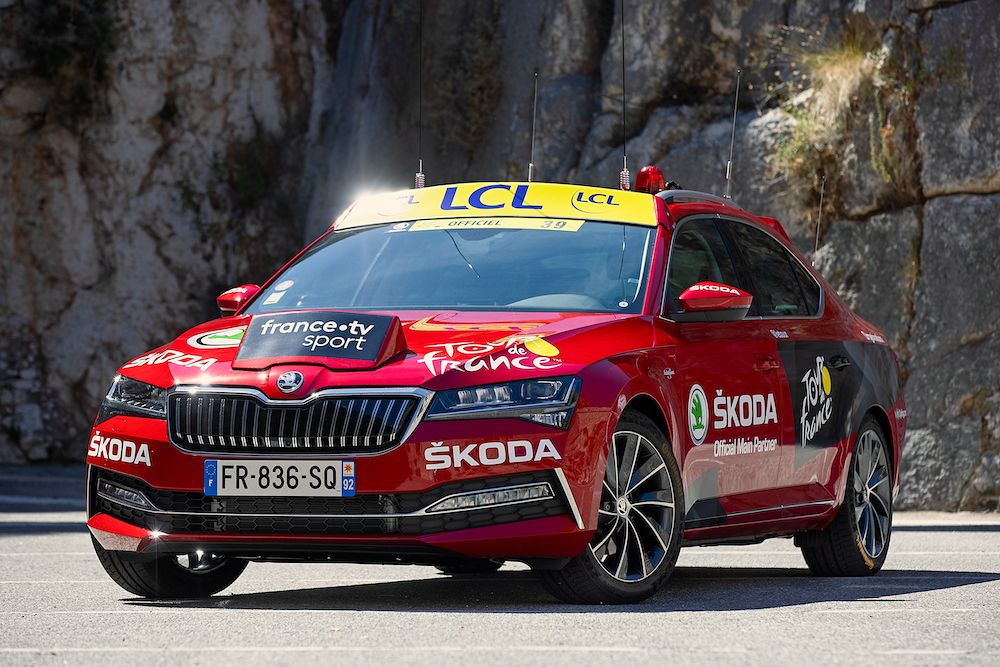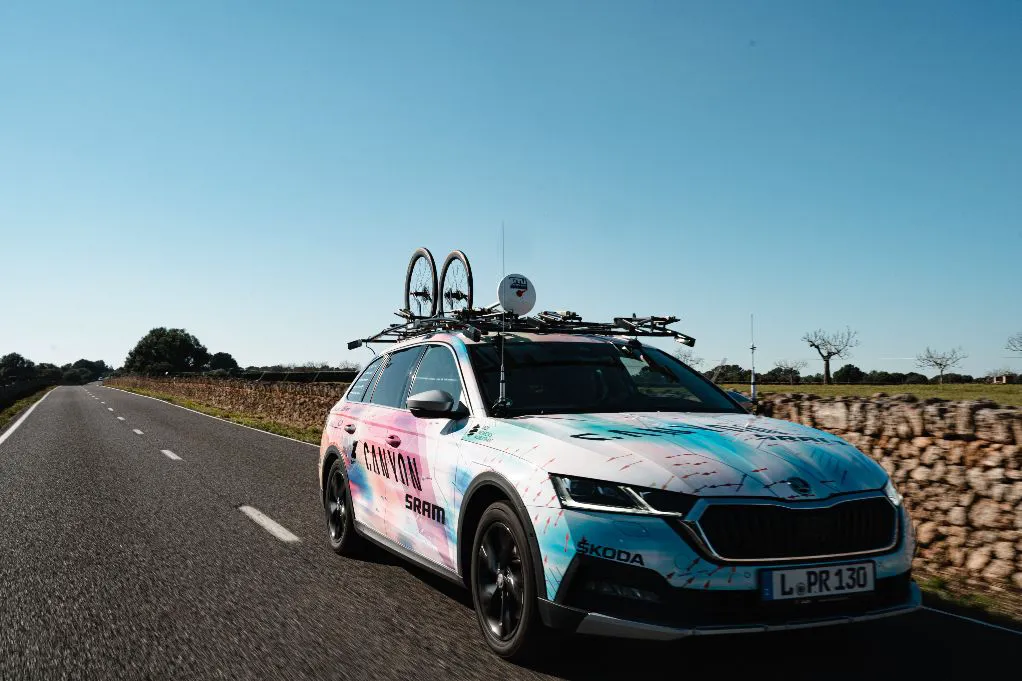A short introduction: Škoda took root as a little cycling workshop founded by Laurin and Klement in 1895. In the words of Martin Jahn, Škoda AUTO Board Member for Sales and Marketing: “Our company’s long history is inextricably linked with cycling. For this reason, Škoda AUTO is committed to being a strong long-term partner of international elite and amateur cycling. Supporting the Tour de France has been one of the cornerstones of our activities in sports partnership since 2004.” Furthermore, after a 33-year hiatus, the Tour de France Femmes will finally take place again this year and Škoda naturally also took up the partnership.
Roughly 210 cars, mostly Škoda OCTAVIAs and SUPERBs, manned by about drivers and technicians, are provided each year for the organisational, team, management, and support crews. Let’s run through them by function.
Directors’ Leading Cars and other high officials’ vehicles
This year, the honour of leading the peloton will once again mostly fall on the specially adjusted Škoda ENYAQ iV that will carry around the Director of the Tour de France, Christian Prudhomme, and the Director of the Tour de France Femmes, Marion Rousse. The striking and well-known ‘Velvet Red’ SUV is used as a mobile command centre, fitted with a two-way radio, six antennas, a retractable panoramic sunroof and all the amenities the Race Directors and their crew need for the four weeks they spend in the cabin, including Champagne flute holders. The radio system is used to communicate with their race marshals and other Tour officials who assist them and the riders on the road, riding in cars of the same brilliant red velvet shade.
The car is not hard to spot amid the Tour’s bustle, thanks to custom decals, the characteristic yellow windscreen visor, and the fact that the Tour Directors often observe and evaluate the situation standing through the sunroof – that’s also how they launch the race by waving a flag at ‘Kilometre Zero’. If you would like a peek at how the Leading Cars and organisers’ vehicles are assembled, customised and readied for their big day, check out our previous article documenting their special modification process in a ‘top-secret’ workshop in the Czech Republic.
https://www.youtube.com/watch?v=d4QPYT5SebI&feature=emb_title&ab_channel=WeLoveCycling
Team cars
One can’t really overstate the importance of Tour de France team cars, usually Škoda SUPERBs and OCTAVIAs, either iV, hybrids or diesel. Their cabins and roofs become jam-packed repair workshops, first-aid stations, spare-parts suppliers, refreshment and gear-change points, and more during the race. This makes them instrumental in the success of both the individual riders as well as the whole team. The cars have an assigned rank depending on the ranking of the team’s leading cyclist. The equation is simple: the closer to the peloton, the fewer seconds spent getting to a rider in trouble. The only one able to hand out permission to break said rank is the Race Director and the team cars have a direct radio hotline to their Leading Car.
Addressing a problem too late may cost the team a stage win or maybe even the Škoda Green Jersey. That’s why you need trained and utterly focused individuals behind the wheel. As Ronny Lauke, Co-Founder and Team Manager of CANYON//SRAM Racing and Sports Director for Tour de France Femmes avec Zwift, told us in an interview: “In my opinion, it’s important for the drivers to be former cyclists. Because it’s difficult to anticipate the movements of a peloton of several hundred riders, which reacts differently in certain situations. […] You are responsible for the athletes’ health and wellbeing – they are the most vulnerable link in our traffic chain.”
Neutral support cars
The new shade still might take some getting used to for regular Tour fans, as the neutral support cars have been sporting the sunny Mavic yellow since 1977. Last year, the Japanese component giant Shimano took over as the provider of the support crews and the Škoda SUBERB iV models utilised as neutral support cars switched coats to royal blue. These ‘angels on four wheels’ are ready to swoop in to help any rider in need when their own team cars are all engaged somewhere else or too far behind. One Shimano car will also keep close to the Race Directors’ cars, with three bikes specially adjusted for the top three general-classification contenders, in case they run into bad luck.
Usually, the neutral support cars are equipped with spare tyres, chains, crank sets and even whole bicycles, as well as accessories like raincoats or miscellaneous things such as energy gels and drinks. Commenting on the change of provider, Thierry Gouvenou, Head of the cycling race organisation department at A.S.O., said: “Having Shimano on board is a huge statement about the quality of races we offer. We have complete trust in the Shimano team to deliver professional service towards teams and riders, as they have been doing for much of their 100-year history.”
VIP Hospitality Programme cars
And last but not least, a dedicated fleet of Škoda cars lets a few lucky winners experience the most important Tour of their lives. Each year, we launch the VIP Škoda Hospitality Programme contest, taking several fans as close to the Tour as possible with all-inclusive service. Winners get to enjoy three days of being chauffeured around in either the Škoda ENYAQ iVs or Škoda SUPERB iVs, including a ride in front of the peloton, a helicopter flight over the racing riders and the scenic landscape, and the famed French cuisine and hospitality. Does this sound like the experience of a lifetime? Try your luck, enter the VIP Škoda Hospitality Programme contest yourself here and see what happens!
This year, keep an eye out for the immensely dedicated and brave support crews and all the others making the dream that is the Tour de France happen!








